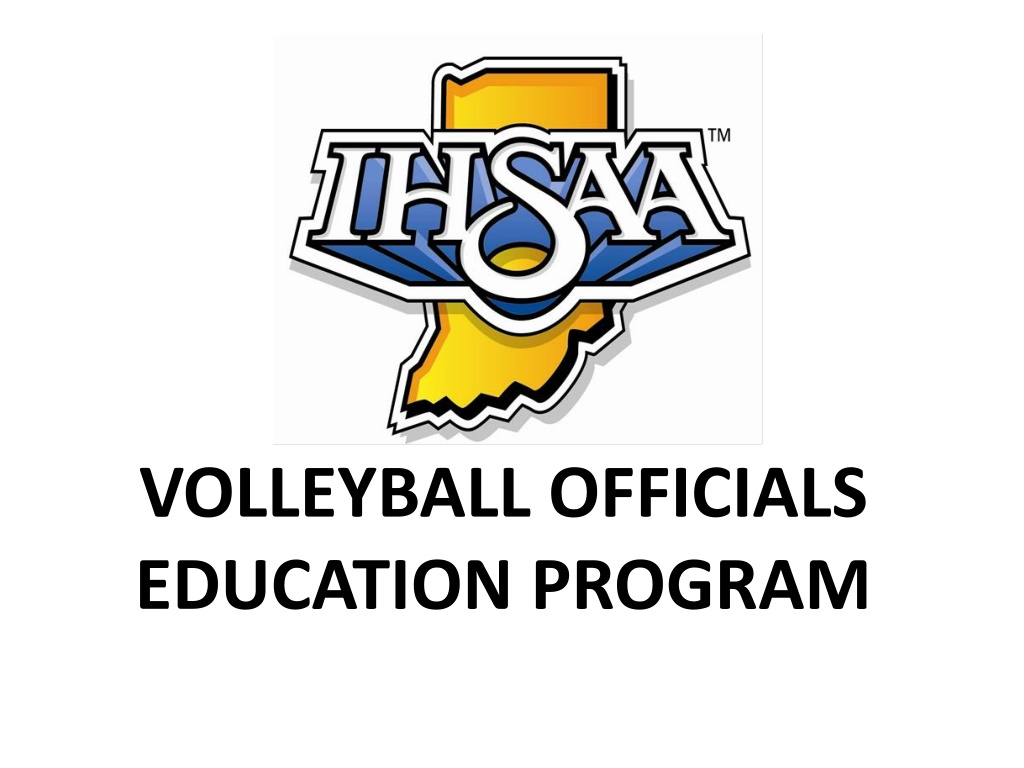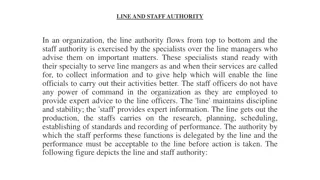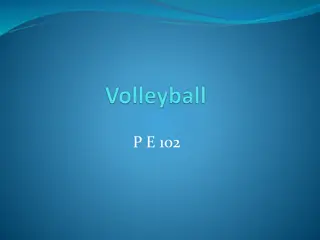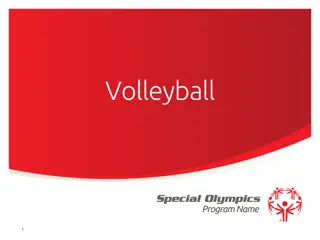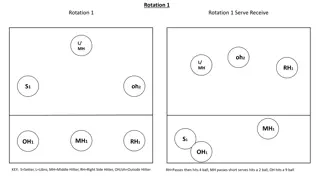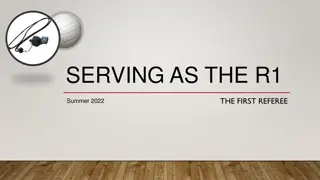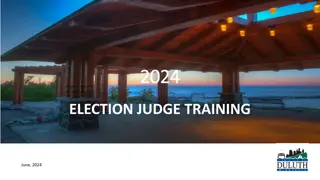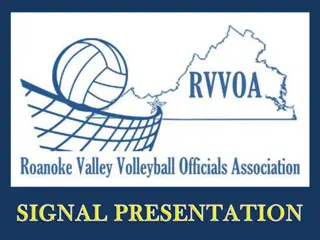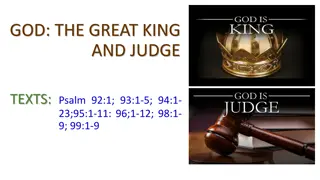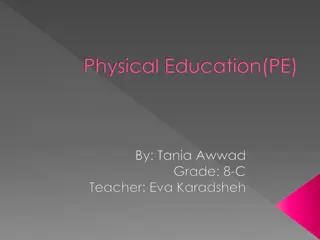Line Judge Responsibilities in Volleyball
In volleyball, line judges play a crucial role in assisting the first referee during matches. They must be carefully selected, trained, and coordinated to ensure fair play. Schools are responsible for recruiting and training line judges, preferably adults, well before the season starts. The first referee oversees the decisions made by line judges, and their input is crucial in close calls at the line. The authority of the first referee is final, but line judges contribute significantly to the match's integrity. Good line judges demonstrate punctuality, attentiveness, and cooperation with match officials. Coaches and players should acknowledge and respect the role of line judges in upholding the rules of the game.
Download Presentation

Please find below an Image/Link to download the presentation.
The content on the website is provided AS IS for your information and personal use only. It may not be sold, licensed, or shared on other websites without obtaining consent from the author.If you encounter any issues during the download, it is possible that the publisher has removed the file from their server.
You are allowed to download the files provided on this website for personal or commercial use, subject to the condition that they are used lawfully. All files are the property of their respective owners.
The content on the website is provided AS IS for your information and personal use only. It may not be sold, licensed, or shared on other websites without obtaining consent from the author.
E N D
Presentation Transcript
VOLLEYBALL OFFICIALS EDUCATION PROGRAM
IHSAA Volleyball Rules IHSAA Volleyball Rules Line Judge Responsibilities Line Judge Responsibilities
TRAINING LINE JUDGES IT IS THE SCHOOL S RESPONSIBILITY TO SELECT, INSTRUCT AND TRAIN LINE JUDGES. Well in advance of the beginning of the volleyball season, school personnel should recruit and select line judges (PREFERABLY ADULTS) who are willing to volunteer their time and services. Training should include practiced and theoretical scrimmages and sessions. The line judge must be able to ignore spectator criticism and maintain complete concentration on the set. It is impossible for the first referee to instruct and train line judges in the short time allotted just prior to a match. Time permits only a brief, general review of their duties and responsibilities.
SELECTING LINE JUDGES IHSAA Line Judges Regular Season The host school is responsible for insuring that line judges are available for each match. The use of adult line judges is preferred, but student line judges may be used during the season. Schools should provided proper training for all individuals performing line judge duties. Tournament Series Sectional, Regional, and Semi-State hosts will select line judges. The IHSAA will select line judges for the state championships. All line judges will be IHSAA licensed officials.
THE R1 IS IN CHARGE Coaches should communicate to players and fans the fact that line judges are assistant officials. They ASSIST the first referee in making decisions. As the head official, all final decisions are made by the first referee. The first referee considers the calls made by the line judges. To encourage the line judges to work hard and stay attentive, the line judge s decision should be used on close calls at the line. The first referee may overrule a line judge s call at any time if he/she believes his/her angle or view was more accurate or if the line judge signaled a no call. In that case, the R1 can make a decision or award a replay.
When dealing with line judges provided by the schools, the match officials must evaluate the experience level of the line judges and make every effort to utilize the line judges abilities so that the match is conducted fairly. If multiple line judges are going to occupy the same position during a match, all of them must attend the pre-match meeting conducted by the match officials.
Characteristics of Good Line Judge 1. Reports to the first referee no less than 20 minutes before the scheduled starting time of the match. 2. Reports promptly to the pre-match meeting with the referees. 3. Is properly instructed and trained in all duties and responsibilities. 4. Performs duties in a confident, quiet, efficient manner. 5. Is appropriately dressed.
Characteristics of Good Line Judge 6. Is always courteous to other line judge, referees, coaches and players. 7. Is cooperative and responds in a positive manner to suggestions and directions from the first referee. 8. Remains detached from players and spectators during the match. 9. Refrains from reacting as a spectator to anything that occurs during the match. 10. Makes objective calls that are both quick and decisive, using the correct signals.
Characteristics of Good Line Judge 11. Concentrates on duties and responsibilities without being distracted by other people. 12. Is always alert and ready to move quickly into the best position to make a call without interfering with play. 13. Shows respect for the calls of other line judge. 14. Shows respect for and accepts, without question, all decisions of the first referee.
1. Line judges are assigned their positions by the first referee. 2. Line judges shall hold these same positions relative to the court throughout the match. 3. Line judges are to make calls for balls landing on or near the sideline and end line closest to them. 4. In general, a line judge should be in a position near the intersection of the left sideline and the end line. 5. Line judges MUST MOVE to be in the best position for an unobstructed view to make the call or to avoid interfering with the server.
GENERAL GUIDELINES 6. On a ball landing in a corner opposite both line judges, both should make the call. An out call by either line judge would warrant an out call by the referee. 7. Line judges never enter the playing area. 8. Line judges must be alert to avoid being struck by the ball or interfering with a player s opportunity to make a play. 9. The use of flags is optional as set forth by the state association. Indiana DOES NOT authorize the use of flags by line judges.
Specific DutiesLine Judges Shall: 1. Determine at the moment of contact for the serve whether the server touches the end line or the floor outside the lines marking the width of the serving area. 2. Indicate when the serve, or any played ball, crosses the net not entirely between the net antennas. 3. Indicate when the ball touches the net, net antenna and/or net supports not entirely between the net antennas. 4. Indicate whether a ball is in bounds or out of bounds when it lands in any area for which the line judge is responsible. 5. Indicate when a player touches a ball that is going out of bounds on the player s side of the net.
6. During a time-out, stand on the respective teams side of the net, at the intersection of the side line and the attack line, near the first referee and hold the game ball when the team on his/her side of the net is serving. 7. Report to the designated, neutral area between sets. 8. Indicate when the ball touches the ceiling or overhead obstruction or enters a non-playable area, if out of the view of the referees. 9. Focus on the line and not the ball when making calls involving lines. 10. Focus on where the ball actually contacts the line or floor and not the shadow of the ball.
1. Line judges must move to get a clear unobstructed view (a straight-on view) of the sideline or end line involved when making an inbounds or out-of bounds call.
2. Line judges must know that some part of the ball that touches the floor must actually touch some part of the boundary line for it to be inbounds. Diagram
3. When a ball is going toward the sideline on the other side of the net the line judge should be lined up with that sideline.
4a. Line judges should consider that the net antennas extend up to the ceiling so the ball must cross the net entirely within the net antennas or within the net antennas extended. b. A ball contacting the antenna within the body of the net is out.
6. Line judges should make their decision quickly and decisively without regard to the call being made by the line judge on the other side of the court. 7. Line judges are part of the corps of officials administering the match. They shall not visit with players on the court or with spectators once they have reported to the first referee prior to the match and until the match is over. 8. Line judges shall not attend any team conferences (huddle) during time-outs or between sets. 9. Line judges should report to either referee, on the next dead ball, inappropriate comments made to them by any team member.
1. The serving team line judge should be positioned to watch for line violations along the end line even if he/she must move to avoid interfering with a server who serves near the left sideline. He/she must be ready to observe the sidelines and net antennas the moment the ball is contacted on the serve. After contact of serve, the line judge should quickly resume original position. 2. If the server serves from the left third of the service area, the line judge on the serving team s side shall move directly back and in line with the extension of the left sideline, out of the peripheral view of the server, until the ball is contacted for serve (dotted line on diagram 2 below). Then the line judge quickly moves back into position at the intersection of the end line and left sideline.
3. The receiving team line judge should be positioned in line with the sideline for which he/she is responsible when the ball is contacted so he/she can observe the sideline and net antennas as the ball crosses the net.
1. Obtaining First Referees Attention: Wave arm overhead to obtain the first referee s attention, when necessary. 2. Inbounds: Arms extended in front of body, hands open (palms down) toward the floor area between the attack line and the net. 3. Out-of-Bounds/Antenna Violation: Hold forearms in front of chest, hands open (fingers together) and palms toward face. 4. Ball Touched: Hand on offending team s side held beside head, palm toward head, then brush upward across fingertips one time with other hand, palm forward. 5. Line Violation: Indicate the line where violation occurred by extending arm and pointing toward the line with the index finger. 6. View of Play Blocked: Cross forearms in front of chest, palms facing the body.
1. Obtaining First Referees Attention 2. Inbounds 3. Out-of-Bounds/Antenna Violation 4. Ball Touched 5. Line Violation 6. View of Play Blocked
